The flea beetle (family Chrysomelidae) is a pesky visitor to most gardens.
The beetle targets tasty plants in the families Solanaceae (potatoes, tomatoes, eggplant, peppers) and Brassicaceae ( including cole crops: broccoli, kale, cabbage, collards).
Its capacity to overwinter in soil and plant debris makes it challenging to manage, and very sneaky. The flea beetle inflicts both above and below-ground injuries to its target.
Above-ground injury is characterized by “shot-holing” in the leaves of the host. Sound unsightly? Well, it is.
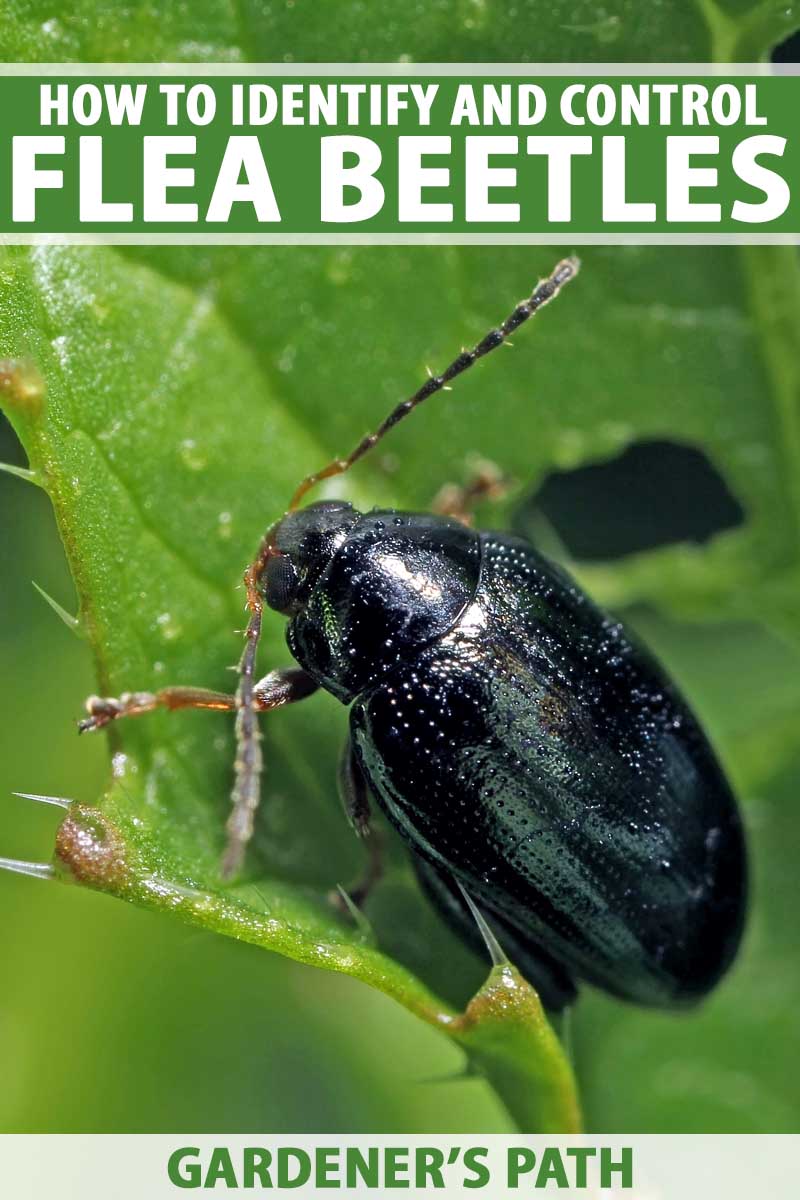
We link to vendors to help you find relevant products. If you buy from one of our links, we may earn a commission.
Shot-holing is a collection of small pits and holes that the insect chews out of the host’s leaves.
Young and recently transplanted plants are particularly susceptible. For the fastidious gardener, this little beetle can cause a lot of frustration!
Just in case the above-ground damage wasn’t scary enough, I’ll continue. Below ground, the larvae feed on the roots and tubers of host plants.
Notable is the damage suffered by potatoes from this insect, resulting in grooves marking the surface or small holes in the skin and outer flesh.
Last spring, my husband I planted the most perfect potato patch. We patiently waited while the precious spuds grew.
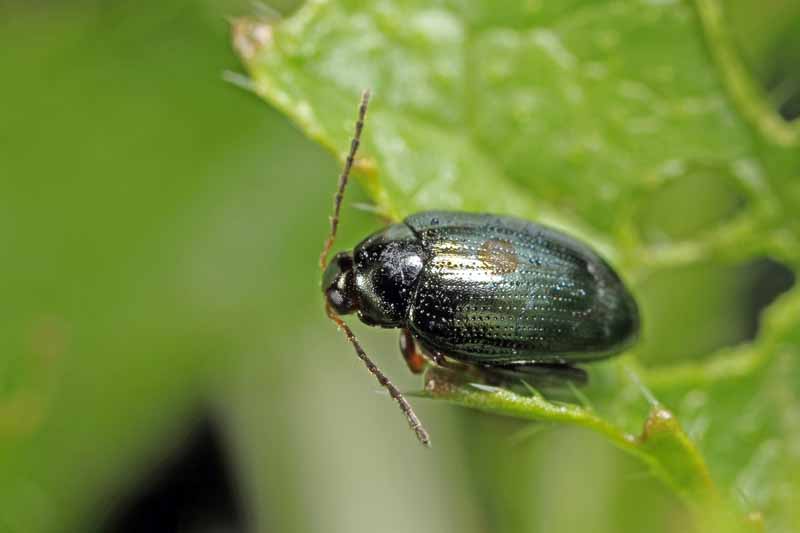
We noticed some small holes dotting the foliage, but nothing too alarming (we thought…).
Dig day arrived, and to our great annoyance, our spuds appeared to have been poked by a ballpoint pen, with dark holes spotting the otherwise beautiful tubers.
Though imperfect produce is often just as delicious as a potato or tomato with a pristine skin plucked from a plant with unnibbled leaves, do you really want to share those crops with the neighbors?
I didn’t think so. So it’s time to get rid of those bugs!
Organic management methods may be employed to combat these pests through cultural, physical, and organic-approved sprays and drenches.
What You’ll Learn
Identification, Biology, and Distribution
The flea beetle is approximately 1/16-1/4 inch long, depending on the type. Its segmented back legs are long, giving it the ability to jump.
And it is also adept at flying. There are numerous species, and their colors vary widely depending on the region where they are found.
The beetles come in some very fancy colors including black, greenish-black, brown, metallic, white-striped, or yellow and orange striped.
Don’t be fooled. Develop a keen eye for spotting these pests, so you don’t have to suffer the devastation of their less-than-creative artwork on your plants’ leaves and tubers.
See the table below to identify some common cruciferous feeders (cole crops like cabbage, kale, and Brussels sprouts) versus solanaceous feeders (nightshade family including tomatoes, potatoes, and eggplant).
These insects identify their feast (read: host plant) based on smell and visual indicators – much like we do!
Flea Beetle Types
| Cruciferous (Cole Crops) Feeders | |
|---|---|
| Crucifer Flea Beetle (Phyllotreta cruciferae) | Black with black legs |
| Striped Flea Beetle (Phyllotreta striolata) | Shiny black with greenish tint and an orange stripe on both wings |
| Western Black Flea Beetle (Phyllotreta pusilla) | Shiny black to dark olive green |
| Solanaceous (Nightshade) Feeders | |
|---|---|
| Potato Flea Beetle (Epitrixcucumeris) | Black with brown legs |
| Eggplant Flea Beetle (Epitrex fuscula) | Black with black legs and ridged back |
Life Cycle
Adult beetles overwinter in the soil, leaf debris, or grassy borders of the garden or field. At just about the same time when we begin to emerge from our homes in springtime, so do they. As temperature warm, they get busy.
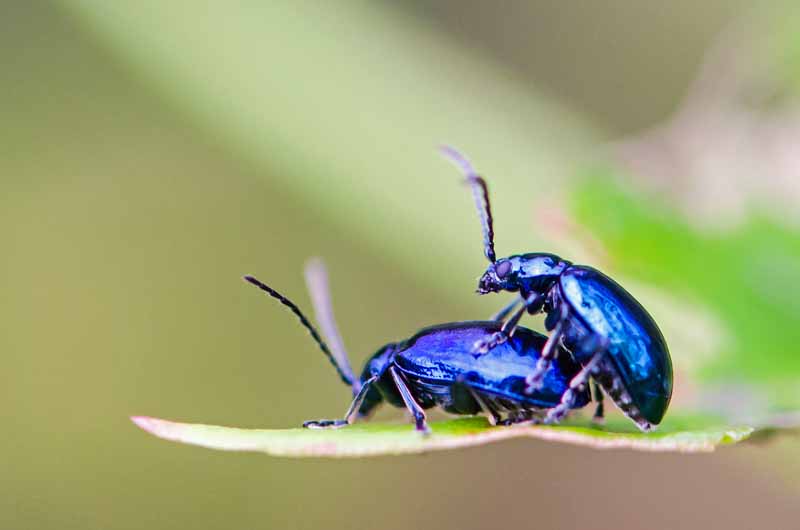
Adults find a healthy host and begin chowing down after a long winter’s nap. Following a hearty meal, the beetles lay their eggs at the base of the host plant.
These eggs will hatch in approximately 10 days, hatching out into small whitish larvae measuring between 1/8 and 1/4 inch long, with dark heads and tiny legs behind.
They are less cute than they sound.
Freshly hatched larvae feed on the roots of plants for the next three to four weeks.
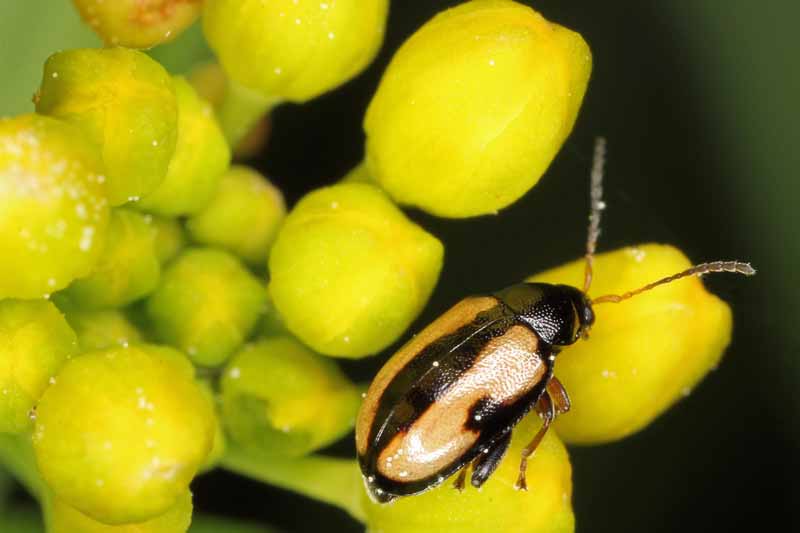
Following this period, they pupate for approximately 7-10 days before surfacing to indulge above ground. In warmer regions, multiple generations may occur each year.
And that’s likely to cause a problem in your vegetable patch, unless you take action.
With some careful planning, preventative measures, and an action plan in place, you won’t have to worry about the safety of your precious broccoli and eggplants.
Damage Caused
Don’t wait until it’s too late!
The flea beetle may cause significant damage to the roots and foliage of your plants. Scouting twice a day for these pests is a good practice in an organic program.
I like to set an alarm on my phone to remind me to check the garden twice during the day.
I grab a little gardening journal that I keep by the back door and trot to the garden for a quick scouting session. I take notes and pictures of what I see, so I will have a record.
This really doesn’t have to take more than a few minutes to accomplish, depending on the size of your garden.
Watch for holes that have been chewed into the leaves by adult flea beetles in the pattern of buckshot, or a messy lace pattern.
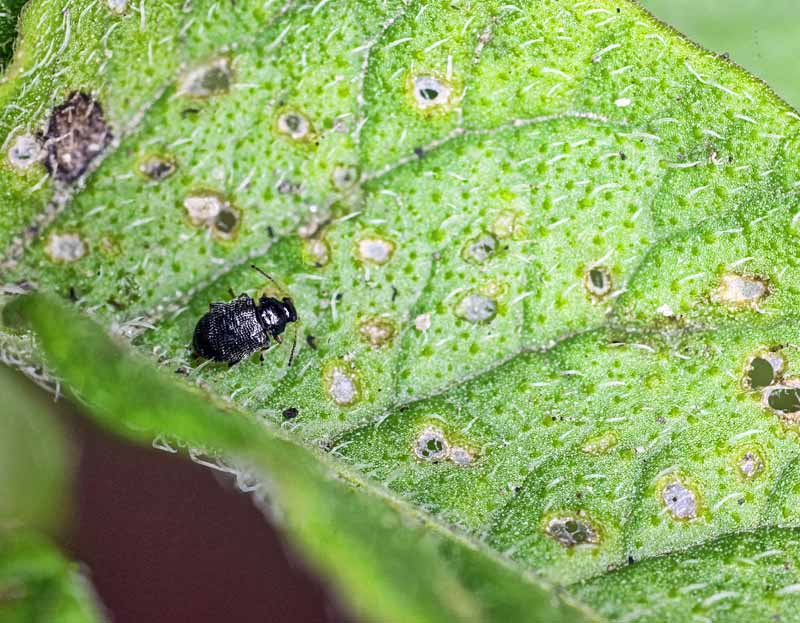
To scout for larval damage, check the roots of a few plants or the tubers of potato plants to look for the whitish larvae munching away, or furrowing grooves in your tubers.
If you’re like me and can’t stand the thought of sacrificing a few plants, you can dig down next to the plant, gingerly move the dirt to the side to take a look, and replace the dirt afterwards.
Be vigilant. If you do have an infestation, take action immediately to avoid further damage, and to remediate this threat to the health of your plants.
Organic Control Methods
There are a variety of methods for controlling these pests, including cultural, physical, and biological.
Cultural
You can often avoid an infestation altogether with some cultural controls.
Planting Schedules
Planting earlier than adult flea beetles become active in springtime can give your plants a head start on the season. And who doesn’t like a good head start?
Plant well hardened-off transplants as soon as the threat of frost has passed in your region.
Another record-keeping tip: If you aren’t keeping a gardening journal already, start one. Record when you plant your first transplants, and when you spot your first beetle.
You have no idea how much this will aid your planting schedule design and pest management routine in years to come (or maybe you already do have some idea, and you just need an extra push to put pen to paper – you’re welcome!).
You may also consider planting your brassica crops later in the summer, when the adults are getting sleepy from all of their summertime feasting and going dormant.
Sanitation
Being diligent about keeping your garden clean and free of too much debris may help to keep pest pressure at bay.
I use the same (okay, maybe a little looser) rules in my garden as I do in my bathroom:
A little cleanup each day keeps the unwanted guests from taking up house. Do your best to keep tall weeds and old piles of leaves out of the garden where these insect pests may overwinter.
Till the Soil
This is a cultural method implemented by many, especially in the spring and fall.
This method is a little gruesome for my taste, but if it’s unwanted pests or my potatoes and broccoli, the choice is a little easier to make.
Tilling in the spring kills the majority of overwintered beetles, while tilling later in the season destroys larvae and cleans up the garden before fall, interrupting the adults’ overwintering patterns.
Though tilling may help with immediate management, its long-term benefits may not be as effective as other cultural management methods – especially if you subscribe to no-till methods and believe in promoting a healthy microbial ecosystem and applying helpful soil microbes.
I am personally of this camp. You can read more about the benefits of a no-till garden here.
Trap Crops
A trap crop acts as a decoy for the main crop. Plant your trap crop before your main crop so that the insects are attracted to your trap crop first. Sacrificial, but usually effective!
If you spot flea beetles in your trap crop, consider spraying or dusting (depending on your chosen method of management) to control the population and keep them from migrating towards the main crop as the trap crop becomes less desirable.
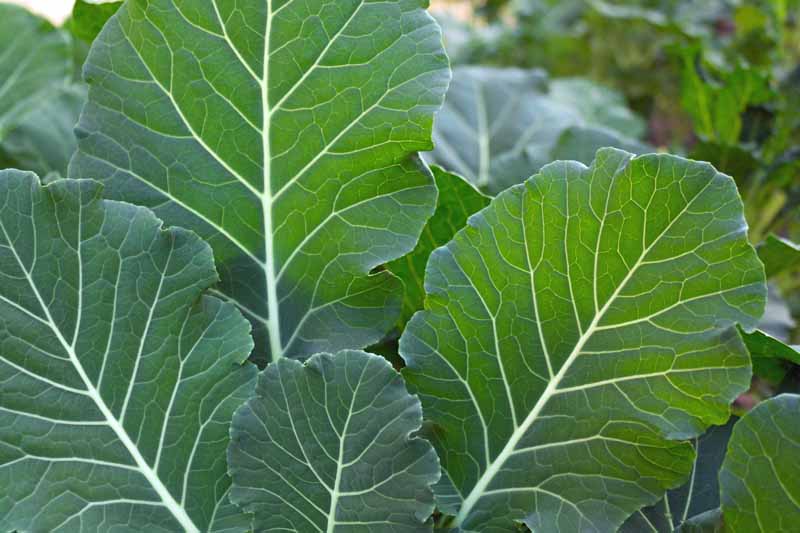
Some recommend tilling under the trap crop once it becomes infested, but this could create a dangerous situation wherein the main crop becomes the primary target.
Some good trap crops include radishes, giant Chinese mustard, collards, and bok choy. The idea is to provide a tempting treat for the insects so they will focus on the trap crop instead of the main crop.
Plant your trap crop around the perimeter or in between rows of your main crop for best results.
Read more about planting and using trap crops here.
Mulches
Both living and non-living mulches help deter these pests from your garden.
Using a living mulch interplanted between rows of your main crop (the insects’ target) confuses flea beetles, thus limiting their ability to identify their target.

Legumes like clover and vetch act as fantastic living mulch between rows, or under-sown. However, do note that living mulches will compete with the main crop for water and nutrients.
Non-living mulches can interfere with the adult flea beetle’s egg-laying. A few options for non-living mulches that I prefer are barley straw and leaf litter.
Keep in mind that it is important to clear these mulches out at the end of the season to prevent providing a perfect overwintering space for adult beetles.
Companion Plants
Intercropping companion plants helps deter flea beetles from the host plant.
Because flea beetles identify their target by smell and visual cues, employing ways to inhibit their capacity to distinguish the host will help protect your main crop.
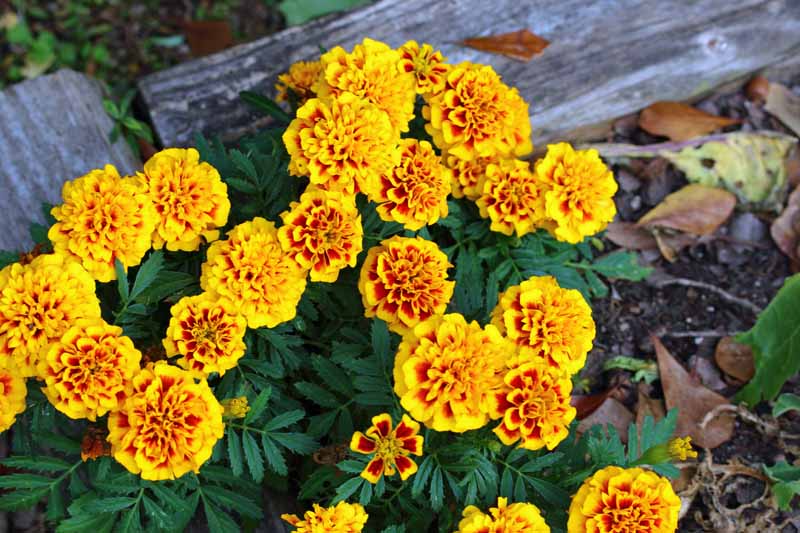
Some plants to consider intercropping include dill, bunching onions, or marigolds.
Diatomaceous Earth
This is a valuable cultural control. Diatomaceous earth (DE) will make your garden look like it survived a flour bomb explosion, but it is a powerful organic weapon to have on hand when you’re going to war with beetles, and various other insect pests.
Sprinkle it on your main crop and around the base of the plants. DE is a powder that is spiny on a microscopic level, and it has a desiccating effect on small insects.

According to Extension.org, it should be applied frequently (two to three times per week) to be used effectively on flea beetles.
Transplant Large Seedlings
Transplanting seedlings that are mature and large is another excellent way to combat flea beetles.
Older transplants may resist pest pressure and recover more quickly if they suffer damage.
Transplanting puny starts (read: baby plants) essentially sends an open invitation to the the transplant’s predators: “Pick me! I’m weak and ripe for the eating!”
A transplant goes through a lot of stress when it is transitioning from its first home, the starter flat that you carefully planted in your guest room or brought home from the garden center, to its permanent spot in the garden.
The healthier it is, the greater chance it has of successfully surviving the big move.
Physical
Physical controls aim to prevent the pests from accessing your crops.
Floating Row Covers
Floating row covers provide a physical barrier between the beetles and the main crop.
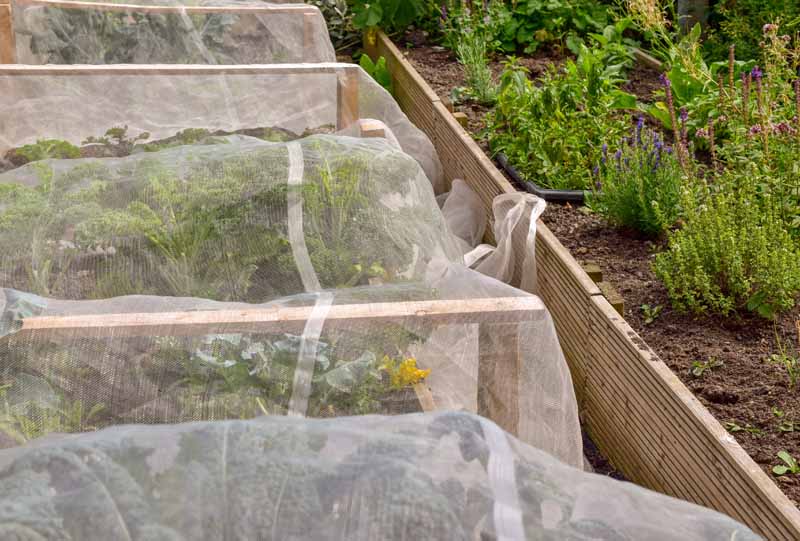
Note that row covers need to be installed before adults are observed, to ensure that they don’t get trapped under the row cover with the main crop.
Also, remember to uncover your plants once they start to flower, so pollinators are able to do their work to ensure that you have a harvest of veggies!
Sticky Traps
These traps may be used to trap insect pests, but their real value comes in helping to scout and identify the insects living in your garden.
Some traps are designed to actually combat pest pressure by attracting and catching specific insects, to keep them from eating your plants.
But usually – and specifically for flea beetles – they are used as a tool for you to more easily get to know who the unwanted visitors are to your garden.
Traps act like low-tech security cameras!
Biological
Biological controls include the use of beneficial nematodes and predatory insects.
Parasites and Predators
There are a variety of generalist predators and parasitic wasps that can help in the effort to manage a flea beetle population.
We cover some of the more common beneficial ones here.
But these predators need hosts, too.
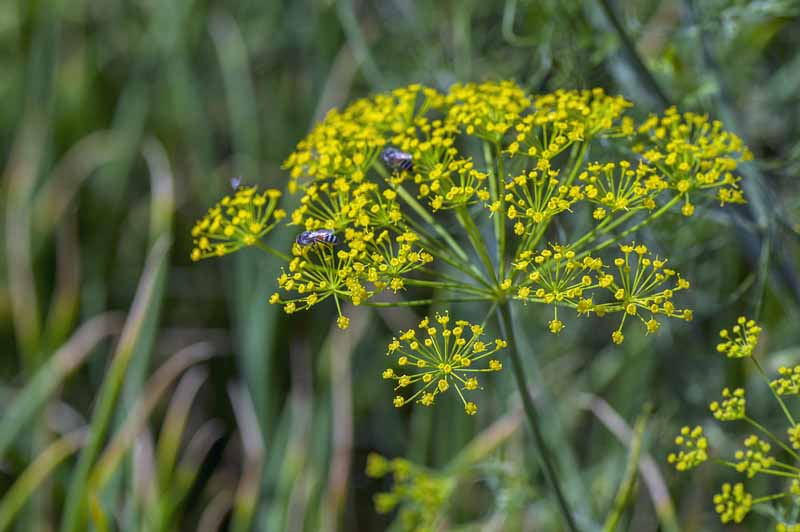
Interplant attractive plants like clover, anise, dill, marigolds, and chamomile to attract these generalists and parasitic wasps.
Nematodes
Entomopathogenic nematodes are small soil-dwelling worms that can effectively kill the larval flea beetle.
Nematodes in the families Steinernematidae and Heterorhabditidae are particularly noted for their capacity to manage populations, while Steinernema carpocapsae are known to manage flea beetle populations in potatoes.
Predatory nematodes like these may be purchased and applied by drench or spray method to control flea beetle larvae.
However, this is not an instant cure and will only work for subsequent generations.
Triple Threat Nematode Bundle via Arbico Organics
One application often works for multiple years, and helps to protect a wild plethora of fruits and veggies against a host of insect pests.
We’d suggest getting a combination nematode bundle like this one from Arbico Organics that is effective against flea beetle as well as other garden pests.
You can purchase this kit in various sizes for coverage ranging from 1,600 sq. ft. up to 10 acres.
Read our complete guide to using beneficial nematodes here.
Fungal Pathogen
Beauvaria bassiana is a fungal pathogen whose spores can kill flea beetle larvae. This little fungus poses a serious threat to its host.
The spores attach to the surface of the beetle, germinate, then infiltrate inside of the larvae and liquify its insides as a source of food for the fungus. Yum!
BotaniGard Beauvaria bassiana Biological Insecticide via ARBICO Organics
This fungal spray may be purchased and sprayed on the garden, but be sure to apply spray in the evening since direct sunlight may kill the spores.
Organic Insecticidal Control
Organic insecticidal sprays, powders, or drenches may be purchased to help combat flea beetles in your garden such as:
- Diatomaceous earth
- Insecticidal soaps
- Neem oil (registered for food crops)
- Pyrethrins
- Sabadilla
- Spinosad
Chemical Pesticide Control Options (If Desperation Strikes)
Chemical pesticides are a last resort option. But if you absolutely need them, here are a few that will aid you in your fight against flea beetles:
- Carbaryl
- Cyfluthrin
- Lambda cyhalothrin
- Malathion
- Permethrin
Check out our article on safe spray practices for advice.
We encourage you to rely on chemical pesticides as a last resort, for the protection of our health and that of the environment.
Put on Your Scout Cap!
Who would have guessed that these tiny little beetles could cause such a fuss?
They sleep in your garden all winter, only to emerge and wreak havoc on your potatoes and broccoli (and their relatives!), shot-holing and furrowing their way through all your hard work.

Well, there’s bad news for the flea beetles everywhere, now that you’ve learned their plan of attack.
Put on your scout cap, and get to work identifying and tackling these pests, utilizing the cultural, biological, and (only if absolutely necessary!) chemical tools that we’ve covered in this article.
What about you? How have you been able to defeat flea beetles? Let us know in the comments below or feel free to ask questions about prevention and control!
And for more information about protecting your garden from insect pests, check out these guides next:
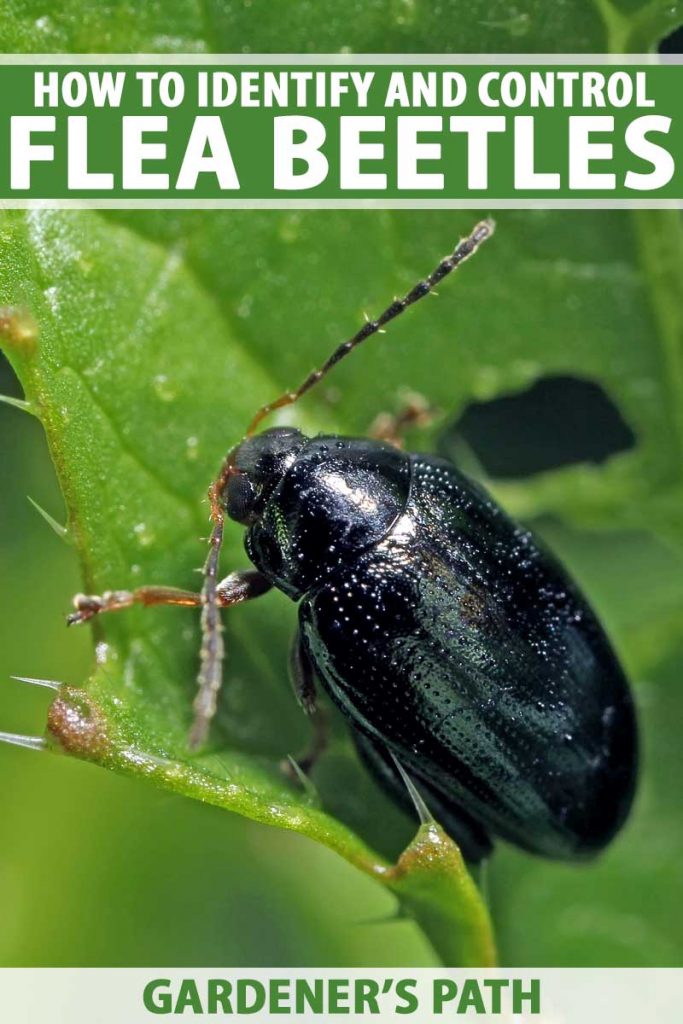

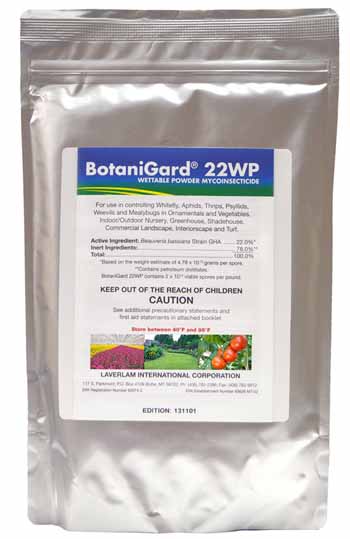
These eggs will hatch in approximately 10 days, hatching out into small whitish pupae measuring between 1/8 and 1/4 inch long, with dark heads and tiny legs behind.
No. Eggs hatch into larvae, larvae feed on the roots then pupate.
good info otherwise
Whoops, thanks for the catch! This has been corrected.
Will they go away on their own after a period of time? Our garden is infested and I just discovered them everywhere after wondering what was killing cucumbers. I found them also on tomatoes, peppers, strawberries. Just everywhere running around and babies all over leaves. It feels helpless for the year and we have a very very large garden. Don’t know how to organically affordably save it. Sprayed some organic spray and it changed nothing.. they are still on same plants.
I am about to try out a home made spray to deter them. So far diatomaceous earth hasn’t helped along with the neem oil that was supposed to work.
2 cups rubbing alcohol, 5 cups water, and 1 tablespoon liquid soap. Test out the mixture on a leaf of the plant, let it sit overnight, then spray the rest of the plant if you don’t notice any adverse effects. Spray the mixture on the foliage of garden plants that are susceptible to these pests.
Spraying coffee worked for me when nothing else did. I have to say I did about 10 captchas and a 15 more again since I had to answer the door and the session expired, to be able to post. It is easier to deter people than the beetles!
I tried the rubbing alcohol/water/liquid soap… All it did was repel them. Plants are still infested.
You have Spinosad (a natural, organic approved Bacteria) in the Chemical pesticide list and Permethrin (a synthetic chemical) in the organic list. These should be fixed.
Hi Matt,
Thank you for pointing that out, oops! We’ve fixed it now, and appreciate your comment.
Are these flea beetles? They seem a little bigger than what you’ve described. My garden is in Northeast Florida, they seem to have flourished during the past few days of extremely heavy rain.
Sorry to see this infestation on your tomatoes, Linda! About how long would you estimate that these beetles are? Since these are larger than what’s commonly found in flea beetles, perhaps this is a type of scarab beetle (aka June bugs or May beetles). It’s difficult to tell from your photo – do the antennae have clubs at the ends? There are also other species of flea beetles that were not covered in detail here.
No, I don’t think those are flea beetles. A flea beetle is much smaller. Here is one I pulled off a tomato plant 2 hours ago (in my garden in southern Ontario). It’s about 1 mm long. I used a cell phone miscroscope.
Yup, that’s the one, Richard. Thanks for sharing this!
Has anyone experienced these little beasts inside the house? I have no idea where they are coming from. We don’t have a garden and I literally only have 3 house plants. They showed up at the beginning of the week and are everywhere!
Hello Selina! I am stumped.
The adults lay their eggs near the stems of plants, and then they hatch from there. And the mature flea beetles can survive the winter in soil or leaf piles, that sort of thing.
Are the houseplants in the great outdoors in the summer? Any other sources of outdoor soil coming into the house? If these are all “no” answers, I’m going to guess you have a different sort of bug.
Please post a photo if you get a chance, and maybe we can get to the bottom of this.
My sweet allysum are covered with black shiny flea beetles and they’ve only been in the garden for two days. I had made sure that they were well watered and protected from the sun. The same thing happened late last summer destroying the florishing allisum. How could they have appeared so soon after transplanting? What to do?
Ugh, so sorry to hear about these flea beetles, Grace Toews. Here is the most likely reason this is happening: Adult flea beetles hang around in your yard and garden in the cold months. Known as overwintering, this process involves them finding a snug spot under the soil or in vegetation, debris, or grassy areas near your garden plot. They spring forth in the warm months, and start munching. You probably planted those alyssum in or near infected soil, which the flea beetles exploited. In brief, the infestation can come from the soil, some weeds, or a stack of debris… Read more »
Hi. I think I read that flea beetles can also infect nightshades with tobacco virus or mosaic virus. My tomato crops have been badly damaged every year. forget about potatoes. Diatomaceous earth twice a week seems like a lot of work. I will give that a try. Coffee? New robot chickens to patrol constantly would be a sweet invention!
Ha, Phil! Please do invent those robot chickens and let me know where I can obtain a few!
I’ve also had trouble with flea beetles on tomatoes and another nightshade, eggplant, so I feel your pain.
And yes, flea beetles are vectors for certain viral and bacterial diseases, notably the uber-destructive bacterial wilt. They can transmit the radish mosaic virus, too, though cucumber beetles are more known for carrying the mosaic virus from plant to plant.
Thanks for weighing in, Phil, and we’d love to hear how you’re faring with this year’s tomatoes.
If the adult flea beetles overwinter in the soil, seems like row covers would be a bad idea. They would emerge and have a protected buffet.
That was my concern. Also a large old growth forest on the other side of the garden fence, that I have no control over
Hello Vera. Thanks for reading! So, as I replied to Susan, above, the row cover is only a good idea in a spot where you haven’t had flea beetles in the previous season or two. As for the old-growth forest that borders your garden fence, the row cover may be exactly the solution for preventing flea beetles that issue forth from its soil. The nematodes or intercropping flowers suggested in the article could work, too. Happily, though, the forest won’t encourage beetles nearly as much as grassy undergrowth would, so maybe you won’t have trouble with flea beetles that emerge… Read more »
That’s a really good point, Susan.
The trick here is to rotate your crops so you’re not growing the same type of vegetable in the spot where you had flea beetles the previous year. If you are practicing a two- or three-year vegetable rotation, row cover should help prevent flea beetles on susceptible seedlings.
But if you have planted in a spot where you had flea beetles the season before, row cover will be an encouragement, not a deterrent. Thanks for writing in!